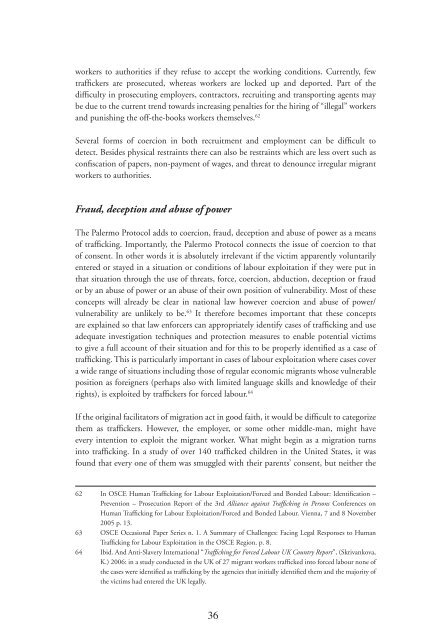Trafficking in human beings: human rights and ... - unesdoc - Unesco
Trafficking in human beings: human rights and ... - unesdoc - Unesco
Trafficking in human beings: human rights and ... - unesdoc - Unesco
Create successful ePaper yourself
Turn your PDF publications into a flip-book with our unique Google optimized e-Paper software.
workers to authorities if they refuse to accept the work<strong>in</strong>g conditions. Currently, few<br />
traffi ckers are prosecuted, whereas workers are locked up <strong>and</strong> deported. Part of the<br />
diffi culty <strong>in</strong> prosecut<strong>in</strong>g employers, contractors, recruit<strong>in</strong>g <strong>and</strong> transport<strong>in</strong>g agents may<br />
be due to the current trend towards <strong>in</strong>creas<strong>in</strong>g penalties for the hir<strong>in</strong>g of “illegal” workers<br />
<strong>and</strong> punish<strong>in</strong>g the off-the-books workers themselves. 62<br />
Several forms of coercion <strong>in</strong> both recruitment <strong>and</strong> employment can be diffi cult to<br />
detect. Besides physical restra<strong>in</strong>ts there can also be restra<strong>in</strong>ts which are less overt such as<br />
confi scation of papers, non-payment of wages, <strong>and</strong> threat to denounce irregular migrant<br />
workers to authorities.<br />
Fraud, deception <strong>and</strong> abuse of power<br />
The Palermo Protocol adds to coercion, fraud, deception <strong>and</strong> abuse of power as a means<br />
of traffi ck<strong>in</strong>g. Importantly, the Palermo Protocol connects the issue of coercion to that<br />
of consent. In other words it is absolutely irrelevant if the victim apparently voluntarily<br />
entered or stayed <strong>in</strong> a situation or conditions of labour exploitation if they were put <strong>in</strong><br />
that situation through the use of threats, force, coercion, abduction, deception or fraud<br />
or by an abuse of power or an abuse of their own position of vulnerability. Most of these<br />
concepts will already be clear <strong>in</strong> national law however coercion <strong>and</strong> abuse of power/<br />
vulnerability are unlikely to be. 63 It therefore becomes important that these concepts<br />
are expla<strong>in</strong>ed so that law enforcers can appropriately identify cases of traffi ck<strong>in</strong>g <strong>and</strong> use<br />
adequate <strong>in</strong>vestigation techniques <strong>and</strong> protection measures to enable potential victims<br />
to give a full account of their situation <strong>and</strong> for this to be properly identifi ed as a case of<br />
traffi ck<strong>in</strong>g. This is particularly important <strong>in</strong> cases of labour exploitation where cases cover<br />
a wide range of situations <strong>in</strong>clud<strong>in</strong>g those of regular economic migrants whose vulnerable<br />
position as foreigners (perhaps also with limited language skills <strong>and</strong> knowledge of their<br />
<strong>rights</strong>), is exploited by traffi ckers for forced labour. 64<br />
If the orig<strong>in</strong>al facilitators of migration act <strong>in</strong> good faith, it would be diffi cult to categorize<br />
them as traffi ckers. However, the employer, or some other middle-man, might have<br />
every <strong>in</strong>tention to exploit the migrant worker. What might beg<strong>in</strong> as a migration turns<br />
<strong>in</strong>to traffi ck<strong>in</strong>g. In a study of over 140 traffi cked children <strong>in</strong> the United States, it was<br />
found that every one of them was smuggled with their parents’ consent, but neither the<br />
62 In OSCE Human Traffi ck<strong>in</strong>g for Labour Exploitation/Forced <strong>and</strong> Bonded Labour: Identifi cation –<br />
Prevention – Prosecution Report of the 3rd Alliance aga<strong>in</strong>st Traffi ck<strong>in</strong>g <strong>in</strong> Persons Conferences on<br />
Human Traffi ck<strong>in</strong>g for Labour Exploitation/Forced <strong>and</strong> Bonded Labour. Vienna, 7 <strong>and</strong> 8 November<br />
2005 p. 13.<br />
63 OSCE Occasional Paper Series n. 1. A Summary of Challenges: Fac<strong>in</strong>g Legal Responses to Human<br />
Traffi ck<strong>in</strong>g for Labour Exploitation <strong>in</strong> the OSCE Region. p. 8.<br />
64 Ibid. And Anti-Slavery International “Traffi ck<strong>in</strong>g for Forced Labour UK Country Report”, (Skrivankova,<br />
K.) 2006: <strong>in</strong> a study conducted <strong>in</strong> the UK of 27 migrant workers traffi cked <strong>in</strong>to forced labour none of<br />
the cases were identifi ed as traffi ck<strong>in</strong>g by the agencies that <strong>in</strong>itially identifi ed them <strong>and</strong> the majority of<br />
the victims had entered the UK legally.<br />
36

















